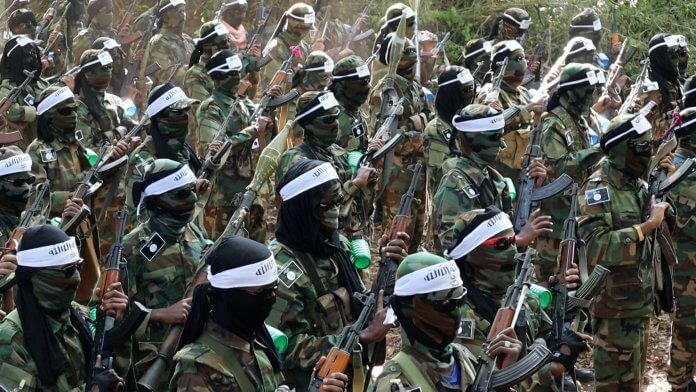MOGADISHU, Somalia – Al-Shabaab, the Somalia-based jihadist militant group affiliated with al-Qaeda, continues to be one of the most resilient and well-funded terrorist organizations in the world.
Despite over a decade of military operations against it by Somali forces, the African Union, and Western allies—including the United States—Al-Shabaab has managed not only to survive but to thrive. One of the key reasons for this persistence lies in its vast and sophisticated financial network.
According to intelligence and United Nations reports, Al-Shabaab generates approximately $200 million annually through a combination of illicit activities, extortion schemes, and taxation systems that rival those of legitimate governments.
A major source of Al-Shabaab’s income is its ability to impose taxes and fees in the territories under its influence or control. The group operates a parallel governance structure in parts of southern and central Somalia, where it collects taxes from residents, businesses, agricultural producers, and even humanitarian aid convoys.
These taxes include levies on farming, livestock, charcoal production, road usage, and port fees. In fact, one of Al-Shabaab’s most profitable ventures is the taxation of the illicit charcoal trade—despite a UN ban on Somali charcoal exports.
The group earns millions by taxing the production and transportation of charcoal, which is shipped from Somalia to countries in the Gulf, particularly the United Arab Emirates.
Traders who attempt to bypass Al-Shabaab’s taxation system often face violence or destruction of their goods, making the group’s economic grip incredibly tight.
Extortion also plays a central role in Al-Shabaab’s financial system. The group has developed a mafia-like protection racket that targets telecommunications companies, construction firms, and even international organizations operating in Somalia.
Businesses are routinely forced to pay monthly fees to avoid attacks on their operations or personnel. Some companies are known to budget these payments as a cost of doing business in Somalia, indicating the normalization of Al-Shabaab’s coercion tactics.
Furthermore, the group has infiltrated formal financial institutions and mobile money networks, allowing it to collect and transfer funds more securely and discreetly.
Its operatives use mobile payment platforms such as Hormuud Telecom’s EVC Plus to receive taxes, extort payments, and fund attacks, often evading detection due to weak regulatory oversight in Somalia’s financial system.
Additionally, Al-Shabaab’s control of key transportation routes, ports, and border areas enables it to collect customs duties and tariffs. The port city of Kismayo, once a stronghold for the group, was particularly profitable due to trade revenues before it was recaptured by Somali and African Union forces.
However, the group still controls significant road networks and checkpoints across the country. Through these checkpoints, Al-Shabaab imposes fees on truck drivers, traders, and travelers, turning every movement into a revenue opportunity.
Some estimates suggest that Al-Shabaab earns as much as $10 million annually from checkpoints alone. These methods have allowed the group to maintain a consistent revenue stream even during military offensives, natural disasters, or economic downturns.
Moreover, Al-Shabaab has benefited from donations from sympathizers in the Somali diaspora and foreign jihadist networks. These contributions are often funneled through informal hawala systems, making them difficult to trace.
While these external funds are not as substantial as the group’s domestic income, they play a strategic role in financing large-scale attacks, recruiting foreign fighters, and maintaining international jihadist alliances.
Intelligence agencies have reported links between Al-Shabaab and criminal enterprises beyond Somalia, including drug trafficking and human smuggling networks that span East Africa, the Middle East, and even Europe.
Despite its designation as a terrorist organization by the United Nations, the United States, and several other countries, Al-Shabaab’s financial strength has made it remarkably durable.
With $200 million a year at its disposal, the group can recruit fighters, acquire weapons, maintain training camps, and launch deadly attacks across Somalia and neighboring Kenya.
This wealth also allows Al-Shabaab to invest in propaganda, governance, and intelligence capabilities, further embedding itself within the fabric of Somali society. It is not merely a terrorist group—it functions as a parallel state in many regions, with courts, police, taxation, and social services, albeit brutal and coercive in nature.
Efforts to dismantle Al-Shabaab’s financial networks have had mixed results. Airstrikes have targeted the group’s financial hubs, raids have captured cash stockpiles, and sanctions have been placed on key operatives and businesses suspected of collaboration.
Nevertheless, the group’s adaptability and deep entrenchment in local economies have made it difficult to eradicate its funding sources entirely.
Tackling Al-Shabaab’s financial base requires not only military action but also a coordinated regional and international approach involving financial regulation, law enforcement, intelligence-sharing, and development assistance that addresses the underlying economic vulnerabilities of Somalia.
Al-Shabaab’s ability to generate $200 million a year underscores the scale and sophistication of its financial operations. Far from being a ragtag insurgent group, it is a powerful and economically astute organization that leverages both traditional and modern financial systems to sustain its agenda.
As long as the group continues to exploit weak governance, informal economies, and local grievances, it will remain a potent threat—not just to Somalia but to regional and global security. Disrupting its revenue streams must be at the heart of any long-term strategy to defeat Al-Shabaab and stabilize the Horn of Africa.

